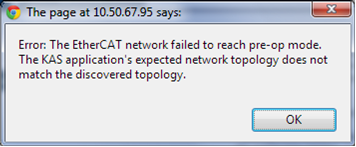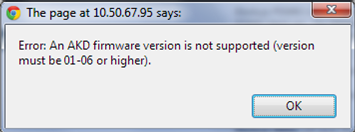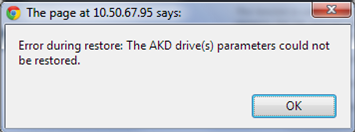Troubleshooting EtherCAT Devices Backup/Restore
The web server displays an error message if an EtherCAT![]() EtherCAT is an open, high-performance Ethernet-based fieldbus system. The development goal of EtherCAT was to apply Ethernet to automation applications which require short data update times (also called cycle times) with low communication jitter (for synchronization purposes) and low hardware costs Device backup or restore fails. The message describes the cause of the failure and a possible remedy. Please be sure to note any error message(s), as they will be helpful with remedying the problem.
EtherCAT is an open, high-performance Ethernet-based fieldbus system. The development goal of EtherCAT was to apply Ethernet to automation applications which require short data update times (also called cycle times) with low communication jitter (for synchronization purposes) and low hardware costs Device backup or restore fails. The message describes the cause of the failure and a possible remedy. Please be sure to note any error message(s), as they will be helpful with remedying the problem.
Described below are some common error messages and remedies. The message box format may appear differently depending on the web browser, but the message content is the same.

- Using the IDE
 "Integrated development environment"
An integrated development environment is a type of computer software that assists computer programmers in developing software.
IDEs normally consist of a source code editor, a compiler and/or interpreter, build-automation tools, and a debugger, open the EtherCAT view and scan the network.
"Integrated development environment"
An integrated development environment is a type of computer software that assists computer programmers in developing software.
IDEs normally consist of a source code editor, a compiler and/or interpreter, build-automation tools, and a debugger, open the EtherCAT view and scan the network. - Compare the nodes, their order, and types to the topology in your application.
- After you identify the differences do one of the following:
- Modify the application’s devices to match the physical network.
- Correct the physical network by adding/moving/removing nodes.

- Using the IDE, open the EtherCAT view.
- Upgrade all of the AKDs drive firmware to at least version 01-06.

Before restoring AKD/AKD2G(s), the backup file must be valid. To correct a bad backup file on a controller, import a known good backup file from another source (local hard drive, network drive, USB![]() "Universal Serial Bus"
USB is a serial bus standard to interface devices flash stick, etc.). If you do not have a valid backup file, then you will need to manually configure the replacement drives by downloading firmware and modifying the drive’s parameters using the AKD/AKD2G views in the IDE.
"Universal Serial Bus"
USB is a serial bus standard to interface devices flash stick, etc.). If you do not have a valid backup file, then you will need to manually configure the replacement drives by downloading firmware and modifying the drive’s parameters using the AKD/AKD2G views in the IDE.
The error message will describe at which step the restore failed. For example, failing to restore parameters:

- If an AKD/AKD2G restore fails and you have already verified the controller has a valid backup and the network topology is correct, then retry the Restore.
- If you still cannot restore successfully after two or three attempts, check your network cables and try a different replacement drive(s). This test will isolate the problem to the specific drive(s) or the controller problem.
- If you still cannot restore a replacement AKD/AKD2G, then you will need to manually configure the replacement AKD/AKD2Gs by downloading firmware and modifying the drive’s parameters using the drive views in the IDE.







